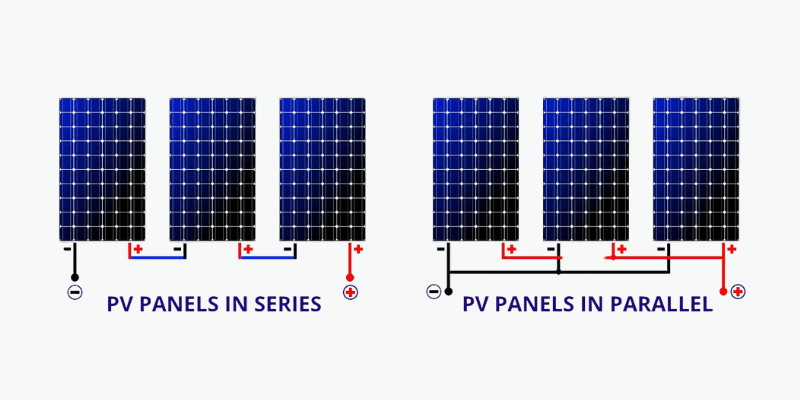När du kopplar flera solpaneler kan du välja mellan serie eller parallella konfigurationer baserat på din ansökan. Låt oss utforska skillnaderna och idealiska användningsområden för varje metod.
Vad är skillnaden? Solpaneler: serie eller parallella
Ledningarna på dina solpaneler påverkar systemets prestanda och inverterare kompatibilitet.
När du kopplar flera paneler i serie ökar den spänningen medan du håller strömmen densamma, vilket hjälper till att möta inverterarens minsta driftspänning.
Däremot ökar parallella ledningar för solpaneler ström utan att ändra spänning, vilket möjliggör energiproduktion inom växelriktarens gränser.
Låt oss undersöka hur man kan koppla paneler i båda konfigurationerna.
Seriesolpanelledningar
Spänning och förstärkare i serie
Att ansluta den positiva terminalen på en panel till den negativa terminalen för en annan skapar en serieanslutning. Denna konfiguration summerar alla panelspänningar, men den totala strömmen förblir lika med en enda panel.
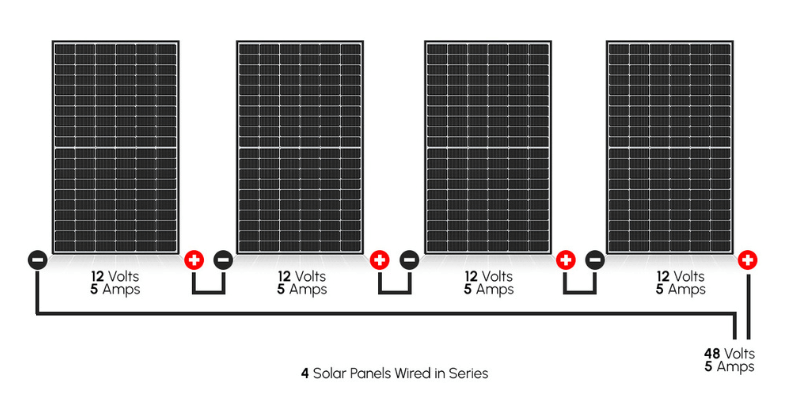
Grafiken ovan visar fyra 12-volt, 5-amp-paneler som är kopplade i serie. Utgångsspänningen är 48 volt (12V*4 = 48V), men utgångsströmmen är fortfarande 5 ampere.
Vad det är bäst för
Solpaneler i serie presterar bäst under oskuggade förhållanden. Om en panel är skuggad minskar den hela systemets effektuttag.
Solpaneler i serie är idealiska för lågförstärkningssystem eftersom högre spänningar resulterar i lägre strömstyrka, vilket möjliggör mindre och billigare ledningar.
När du kopplar dina paneler i serie måste du använda en MPPT Charge Controller. MPPT -styrenheter justerar spänningen och strömmen från solpanelerna för att matcha batteriets spänning utan att förlora kraft. Om du använder en PWM -styrenhet sänker batteriet den totala panelmatrisspänningen, vilket resulterar i betydande effektförlust.
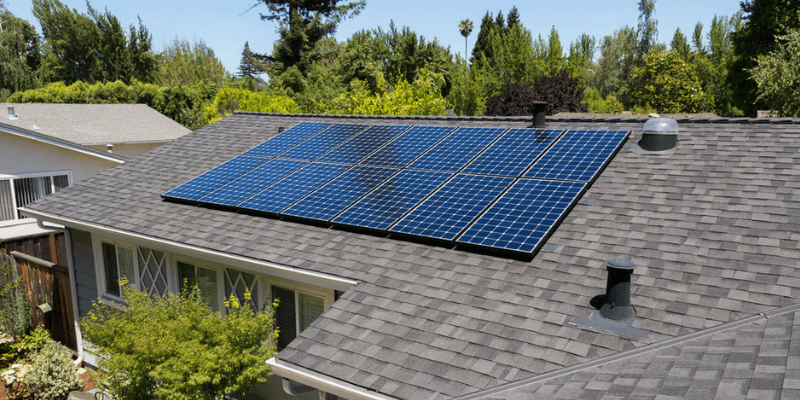
Parallell solpanelledningar
Spänning och förstärkare parallellt
För att koppla solpaneler parallellt, anslut alla positiva terminaler tillsammans, liksom de negativa terminalerna. Den resulterande strömmen kommer att vara lika med summan av alla panelområden, medan den totala spänningen matchar den ena panelens utgångsspänning.
När flera paneler är kopplade parallellt bildar den en PV -utgångskrets.
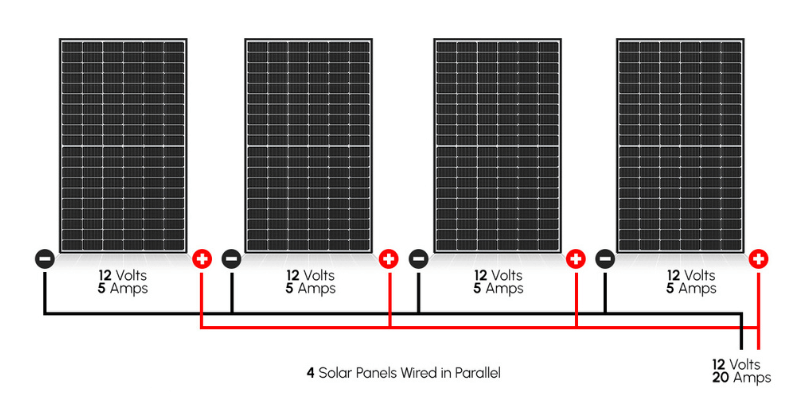
Grafiken ovan visar fyra 12-volt, 5-amp-paneler som är kopplade parallellt. Utgångsströmmen är 20 ampere (5a*4 = 20a), men utgångsspänningen är fortfarande 12 volt.
Vad det är bäst för
Solpaneler fungerar i parallellt oberoende, vilket gör dem bra för förhållanden med blandat ljus. Om en eller två paneler är skuggade kommer de andra fortfarande att generera kraft.
De är också lämpliga för lågspänningssystem med billigare PWM-styrenheter, eftersom ledningar parallellt inte ändrar den totala utgångsspänningen. Denna inställning gör att du kan öka laddningsströmmen utan att behöva reglera spänningen, förutsatt att panelutgången matchar batteriladdningsspänningen.

Solpaneler: serie eller parallella, vilket är bättre?
Nu när vi förstår skillnaderna mellan ledningssolpaneler i serie och parallella, låt oss diskutera vilka som är bättre för din applikation.
Kablarpaneler i serie är ofta idealiska om du kan hålla dem mestadels oskuggade. Denna installation förbättrar effektiviteten, särskilt under förhållanden med svagt ljus som tidiga morgon eller molniga dagar.
Högre spänning behövs för att ladda batterier; Till exempel kräver våra litiumbatterier 14,4 volt för att börja ladda. De flesta 100-watt paneler matar ut 18-20 volt, så att koppla dem parallellt kräver att man arbetar med över 75% kapacitet.
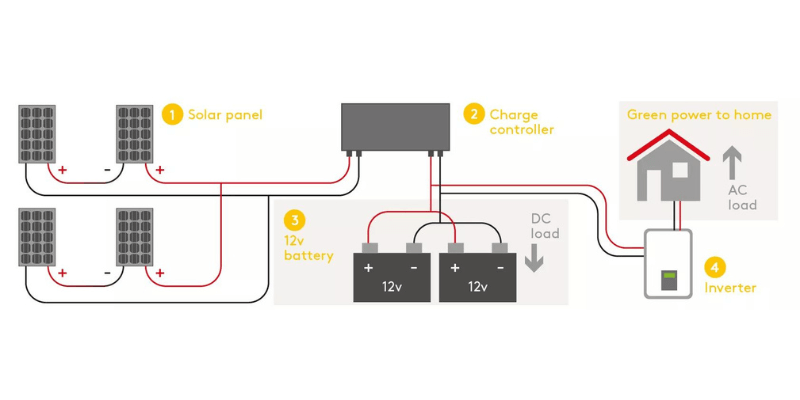
Däremot producerar anslutning av tre av dessa paneler i serie 54-60 volt, vilket gör att matrisen kan fungera med cirka 25% kapacitet för effektiv laddning – Mycket lättare även sent på dagen eller på molniga dagar. Observera att en MPPT -laddningskontroll är nödvändig för detta system.
Kabeldragning parallellt är dock inte heller ett dåligt alternativ. MPPT -styrenheter är dyra och kan vara överdrivna för små inställningar som husvagnar eller båtar med variabla belysningsförhållanden. I sådana fall kan ett parallellt system fungera bra med en lägre kostnad PWM-laddningskontroller, vilket sparar pengar.
Serie eller parallell för blandningstyper
Du kan blanda solpaneler från olika tillverkare, men villkoren skiljer sig åt serie och parallella konfigurationer.
Misjaktade solpaneler i serien fungerar vid den lägsta förstärkaren. I vårt första exempel, om du ersätter en panel med en fyra-amp-panel, kommer hela systemet att mata ut fyra ampere.
I parallella ledningar ökar den förstärkarna medan spänningen håller densamma.
Slutsats
Det finns inget definitivt svar för ledningssolpaneler i serie eller parallella, eftersom båda har fördelar och nackdelar. Ledningar i serien ökar spänningen, medan ledningar i parallellt ökar strömstyrkan. Valet beror på dina specifika behov och tillämpning.
Relaterad artikel:

